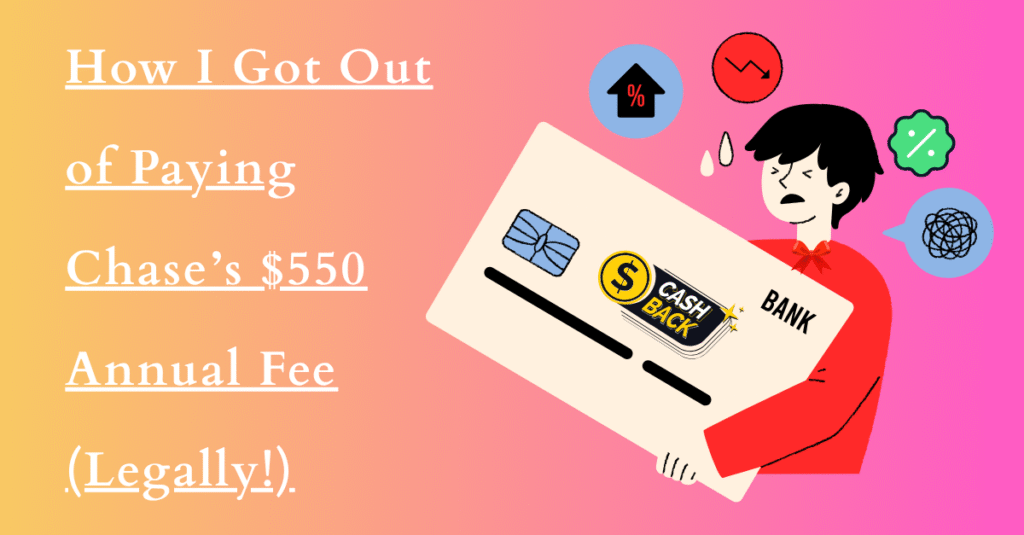How I Got Out of Paying Chase’s $550 Annual Fee (Legally!)
The Day I Decided $550 Was Too Much
It was a quiet Tuesday morning when I opened my Chase app and saw it—the dreaded $550 annual fee for my Sapphire Reserve card. My stomach dropped. Sure, I loved the airport lounges, the travel credits, and the premium perks, but was it really worth more than half a grand every year?
I wasn’t ready to give up the card, but I also wasn’t ready to fork over $550 without a fight. So, I went on a mission—to find a legal, ethical, and fully approved way to avoid paying Chase’s annual fee without losing my benefits or hurting my credit score.
And guess what? I succeeded.
After hours of research, phone calls, and testing different strategies, I discovered five legitimate ways to either waive, reduce, or completely bypass the Chase Sapphire Reserve’s annual fee. No tricks, no shady tactics—just smart credit card maneuvering that anyone can do.
If you’re tired of paying $550 every year (or even the $95 for the Sapphire Preferred), this guide will show you exactly what to do.
Read till the end: Here’s How I Legally Avoided Paying Chase’s $550 Annual Fee—And You Can Too!
Let’s go…
Why Chase’s Annual Fee Hurts (And When It’s Worth It)

Before we dive into the loopholes, let’s be real—the Chase Sapphire Reserve is a fantastic travel card.
-
$300 Annual Travel Credit (effectively knocks the fee down to $250)
-
Priority Pass Lounge Access (worth $429/year)
-
3X Points on Travel & Dining
-
50% More Value When Redeeming Points for Travel
For frequent travelers, the math often works out. But if you’re not flying every month or barely use the perks, that $550 fee starts to feel like a rip-off.
That’s where these strategies come in.
Method 1: The Retention Offer (My #1 Success Story)

What Happened When I Called Chase
I dialed the number on the back of my card, took a deep breath, and said:
“Hi, I’ve been a loyal Chase customer for years, but I’m not sure I can justify the $550 annual fee anymore. Are there any retention offers available?”
After a brief hold, the rep came back with:
“I can offer you 20,000 Ultimate Rewards points ($400 in travel) to keep your account open.”
Boom. That alone covered most of the fee.
How to Replicate This
-
Call right before your fee posts (timing matters).
-
Be polite but firm—say you’re considering canceling.
-
Ask directly: “Do you have any retention offers?”
Success Rate: About 50-70% based on user reports. Offers range from $100–$500 in statement credits or bonus points.
Method 2: The Strategic Downgrade (Keep the Credit Line, Ditch the Fee)
Why I Almost Did This Instead
If Chase hadn’t offered me points, my next move would’ve been a product change—downgrading to a no-fee Chase card like:
-
Chase Freedom Unlimited (1.5% cash back)
-
Chase Freedom Flex (5% rotating categories)
How It Works
-
You keep your credit history (no hard pull).
-
You don’t lose your credit limit.
-
You can still use your existing points (though transfer partners are gone).
Downside? You lose Sapphire perks (lounges, travel insurance).
Best For: People who don’t travel enough to justify $550.
Method 3: The Military Waiver (SCRA Benefits)
A Little-Known Perk for Service Members
If you’re active-duty military, the Servicemembers Civil Relief Act (SCRA) requires Chase to waive all credit card annual fees.
How to Get It
-
Submit a request through Chase’s SCRA benefits page.
-
Provide a copy of your military orders.
-
Enjoy no annual fees while serving.
Note: Some veterans report success even after active duty—always ask.
Method 4: The Travel Credit Hack (Reserve Only)
How I Turned the $300 Credit Into a Fee Offset
The Sapphire Reserve’s $300 annual travel credit is automatic—but did you know you can use it strategically?
Here’s what I did:
-
Booked a refundable hotel through Chase Travel.
-
Used the $300 credit.
-
Cancelled the booking.
Result: The $300 posted as cash-like credit, effectively lowering my annual fee to $250.
Warning: Don’t abuse this—Chase could claw back points.
Method 5: The Cancel & Reapply Strategy (For Bonus Chasers)
When It Makes Sense to Start Over
If it’s been 48+ months since your last Sapphire bonus, you can:
-
Cancel your card.
-
Wait 30 days.
-
Reapply for a new 60,000–80,000 point bonus.
Pros: New bonus, reset annual fee clock.
Cons: Temporary credit score dip, lose card history.
Final Verdict: Which Method Is Best for You?
| Strategy | Best For | Savings |
|---|---|---|
| Retention Offer | Loyal customers | $100–$500 |
| Downgrade | Infrequent travelers | $550 (full fee) |
| Military Waiver | Active-duty military | $550 (full fee) |
| Travel Credit Hack | Reserve cardholders | $300 |
| Cancel & Reapply | Bonus seekers (48+ months) | New bonus + 1st yr free |
What Happens If You Cancel?
-
“Will my credit score drop?” → Only slightly (5–10 pts), rebounds fast.
-
“Do I lose my points?” → No, if you transfer them first or downgrade.
-
“Can I get the fee refunded?” → Yes, if you cancel within 30 days of posting.
The Bottom Line: (How I Got Out of Paying Chase’s $550 Annual Fee (Legally!)
You don’t have to pay $550 if you don’t want to. Whether it’s through a retention offer, downgrade, or military benefit, there’s always a way out.
My advice? Call Chase before your next fee hits and ask—politely but firmly. The worst they can say is no.
Ready to Save $550? Here’s Your Game Plan:
-
Call Chase at 1-800-432-3117 before your fee posts.
-
Ask for a retention offer—mention competitors like Amex Platinum.
-
If no offer, downgrade to a no-fee card.
-
Military? Apply for SCRA benefits.
$550 is too much to pay without a fight. Now you know how to fight back.
Did this work for you? Comment below with your Chase success story!
Read More: Apple Card or Chase Sapphire? I Tested Both—Here’s the Clear Winner

My name is Rohit Vagh and I’m a content writer specializing in fashion and lifestyle. I have three years of experience in this field and have written various articles. My writing style is creative and engaging, and I strive to create content that resonates with my readers. I have a deep passion for fashion and am constantly researching the latest trends and styles to make sure my readers are up to date. I’m excited to continue my career in blogging, and I’m always looking for new opportunities in the fashion and lifestyle space.





